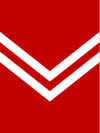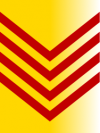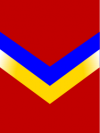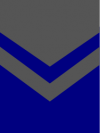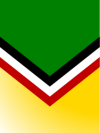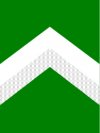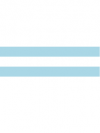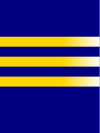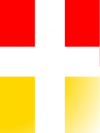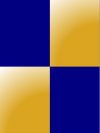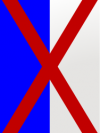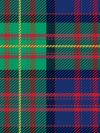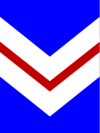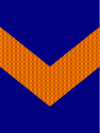Heraldic Patterns
On 16 May 1895, the Intercollegiate Commission on Academic Costume approved a uniform system of academic costume for American colleges and universities called the “Intercollegiate Code of Academic Costume”. The Intercollegiate Code stipulated that the college color or colors of the institution granting the degree would be used in the silk or satin lining of the institution’s hood but did not define how multiple colors would be combined in the hood lining.
One of the advisors to the Commission was Gardner Cotrell Leonard, the Director of the Intercollegiate Bureau of Academic Costume, an organization affiliated with the academic costume manufacturing firm Cotrell & Leonard. Since 1887 the Bureau had maintained a database of information about academic regalia in the US and Europe, so the Commission entrusted the Intercollegiate Bureau with the responsibility of assigning a unique hood lining design to every college and university that chose to adopt the Intercollegiate Code. But as an article in the 27 July 1902 edition of an Albany, NY newspaper named The Argus recalled, “the combining of two or three colors in a lining was a great problem with the commission but was solved by Mr. Leonard after some study in heraldry by the chevron, double and triple chevron, and parti-per-chevron.”
These early heraldic divisions of the school colors — and more that followed — became the means by which a variety of distinctive hood lining patterns could be individually assigned to each school that chose to follow the Intercollegiate Code.
In the list below, each full-color hood lining diagram is a link to the college or university it represents. Click on the hood lining to be taken to a webpage where you can learn about the history of that school’s particular color or colors and hood lining pattern.
When the Intercollegiate Code of Academic Costume was written in 1895, some colleges and universities had only one official school color. In these cases, the Intercollegiate Bureau authorized a single-color hood lining. Unfortunately, this led to a number of hood duplications, as there was no second color to employ as a heraldic ordinary. On this website the Intercollegiate Registry of Academic Costume has often resolved these duplications by assigning a hood lining tailored from velvet fabric (instead of the standard silk or satin lining) to the second college or university with the same color. See below under “special fabric” for more discussion on this topic.
Beginning in 1895, most colleges and universities were assigned a hood lining pattern that used a chevron to divide the two or three school colors. Gardner Cotrell Leonard conceived of the hood lining as an inverted shield, so what he called a “chevron” is actually an inverted (or “reversed”) heraldic chevron. The standard width of the chevron was four to five inches, depending upon the size of the academic hood. Bachelor’s and Master’s hoods, which were smaller and thus had a smaller lining area on display, would use a chevron that was four inches in width, whereas a doctoral hood might use a chevron up to five inches in width.
Today, many hood manufacturers create hoods with chevrons that are more than five inches in width, which is unfortunate. The traditional four- to five-inch chevron is to be preferred because it allows more of the color above the chevron to be displayed when the hood is properly folded and worn.
On rare occasions the Intercollegiate Bureau of Academic Costume would assign a college or university a hood lined with a “wide chevron”. Instead of the standard chevron that was four to five inches in width, these hood linings used a chevron 5½ inches, six inches, or seven inches in width (or more). Sometimes the latter would be called a “double width chevron”, or the hood would be said to be divided into “equal parts”. These wide chevron patterns appear for the first time in a 1918 Intercollegiate Bureau list, but were not used very often because it was difficult to see the upper color when the hood was correctly folded and worn, which caused the hood lining to have the appearance of being divided per chevron (see below). To avoid this problem, this website has replaced linings the Bureau assigned a “wide chevron” with linings that use two or three chevrons, when available.
A hood lined with a single thin chevron did not appear in a Intercollegiate Bureau list until 1972. The chevron was about 1½ to two inches in width. On this website the Intercollegiate Registry of Academic Costume has avoided using the single thin chevron, as it is easily confused with a standard-width chevron.
Beginning in 1895, the Intercollegiate Bureau would often employ two chevrons to distinguish between colleges and universities that used the same shades of two colors. Here each chevron was approximately two inches in width and was placed about one inch apart so that the lining color showed between them. This pattern is sometimes referred to as a “double chevron”.
On rare occasions the two chevrons were of different colors, for colleges or universities that had three school colors. Only two schools had been assigned this type of hood lining pattern by 1927.
For additional variety among schools that used the same shades of two colors, the Bureau would occasionally assign a college or university a hood lined with three chevrons, each 1½ to two inches in width and placed about one inch apart so that the lining color showed between them. Starting in 1895 this pattern was sometimes referred to as a “triple chevron”, and on rare occasions the chevrons were of different colors.
This heraldic pattern appears for the first time in a 1948 Intercollegiate Bureau of Academic Costume list for a college that had three school colors. Two chevrons approximately two to 2½ inches in width were placed side-by-side so that the lining color did not show between them.
Another option, never used by the Intercollegiate Bureau, would be to adapt this pattern for a school with two school colors, which would create the unusual aesthetic appearance of a hood lining divided per chevron with a thin chevron either above or below the division. The Intercollegiate Registry of Academic Costume has used this on at least one occasion.
Beginning in 1895 the tri-chevron pattern was infrequently used for a handful of colleges and universities that had three or more school colors. Each section of the tri-chevron was approximately 1½ to two inches in width. The primary difference between a tri-chevron and a double or triple chevron is that the color of the lining does not show between the three chevrons.
From time to time the Intercollegiate Bureau also authorized the use of what it called a “reversed” (or “inverted”) chevron. In European heraldry this point-up design is simply known as a “chevron”. It is not known precisely when the Bureau began to use the reversed chevron; perhaps as early as 1895 but almost certainly by 1902.
THIN REVERSED
CHEVRON

There are no recorded examples of a hood lined with a thin reversed chevron in Intercollegiate Bureau materials, and it is a heraldic pattern the Intercollegiate Registry of Academic Costume has avoided because it is easily confused with a standard-width reversed chevron.
Since the Intercollegiate Bureau had authorized the use of hoods with two chevrons in 1895, the Bureau may have also approved the use of hoods lined with two inverted chevrons at the same time, but no documents with this pattern have appeared prior to 1927. Each reversed chevron would have been approximately two inches in width and placed about one inch apart so that the lining color showed between them. Apparently for reasons of space, some of the early colleges and universities the Bureau had assigned two reversed chevrons were cited in 1927 and 1948 Intercollegiate Bureau of Academic Costume lists as having a hood lined with “two chevrons”, not “two reversed chevrons”.
The Bureau may have begun assigning a few colleges and universities hoods that were lined with three reversed chevrons in the first decade of the 1900s, but no documented examples have been found prior to the 1960s. Each inverted chevron was approximately 1½ to two inches in width and placed about one inch apart so that the lining color showed in between them.
The Intercollegiate Bureau of Academic Costume did not approve a reversed bi-chevron design until the 1960s. On a reversed bi-chevron, each inverted chevron is about two to 2½ inches in width and placed contiguously so that the hood lining does not show between them. Normally the two thin chevrons are different colors, but on the example to the right, the upper chevron is white satin and the lower chevron is white velvet.
Apparently the Intercollegiate Bureau of Academic Costume never registered a hood lining design of this type to any college or university, but today the Intercollegiate Registry recommends this pattern as an unusual option for colleges and universities that have three or more school colors. Each chevron is about 1½ to two inches in width and placed side-by-side so that the lining color does not show between them.
Instead of a chevron, the Intercollegiate Bureau would sometimes use a horizontal bar about four or five inches in width to divide the two or three colors in a hood lining. The Bureau referred to this as a “zone” of color. The first appearance of this pattern is in a 1902 Intercollegiate Bureau of Academic Costume list, but it may have been in use since 1895.
THIN BAR
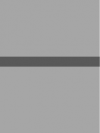
The Intercollegiate Bureau never approved a hood lined with a thin bar 1½ to two inches in width, probably because it would be easily confused with a standard-width bar.
The Intercollegiate Bureau of Academic Costume apparently did not assign this pattern to any college or university using three colors, nor has the Intercollegiate Registry.
Like the bi-chevron and reversed bi-chevron (see above), the bi-bar would be a visually interesting hood lining option for schools that have two school colors.
BI-BAR
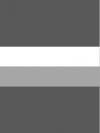
TRI-BAR
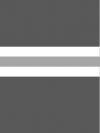
No examples of this hood lining pattern have been found in any Intercollegiate Bureau documents. Today, the Intercollegiate Registry of Academic Costume has not yet assigned it to a college or university.
Beginning in 1895, a heraldic pattern the Intercollegiate Bureau of Academic Costume commonly employed to differentiate between colleges and universities that used the same shades of two colors was the “parti per chevron”. In 1910 and 1927 lists from the Bureau these hoods were described as “[color] above [color]” and in a 1948 Intercollegiate Bureau list they were described as “[color] over [color]”, but see the discussion under “parti per bar” below for a cautionary note regarding these descriptions.
Gardner Cotrell Leonard, the president of the Intercollegiate Bureau of Academic Costume, had started assigning some schools a hood lined with two colors divided per reversed chevron perhaps as early as 1895 but certainly no later than 1908. It first appears in an IBAC list from 1918. Unfortunately, Intercollegiate Bureau lists from 1927 and 1948 did not distinguish between hoods lined with a division per chevron and hoods lined with a division per reversed chevron, citing all of these hoods identically as “[color] above [color]” or “[color] over [color]”.
Like the parti per chevron and parti per reversed chevron patterns, the Intercollegiate Bureau of Academic Costume introduced the parti per bar pattern at some point between 1895 and 1908. Intercollegiate Bureau lists from 1927 and 1948 described these hood linings as “[color] above [color]” or “[color] over [color]”, the same description used for hoods known to have been divided parti per chevron or parti per reversed chevron.
What this means is that the schools with hood linings described this way in the 1927 and 1948 Intercollegiate Bureau lists could have had their colors divided either per chevron, or per reversed chevron, or per bar, and unfortunately there is no way to know today which was which, unless archival examples turn up or the school hoods are more accurately described in other historical sources.
This website assumes that the first institution the Bureau assigned a “[color] above [color]” pattern had its hood colors divided per chevron, the second school to be assigned had its hood colors divided parti per reversed chevron, and the third school to be assigned had its hood colors divided parti per bar, unless the heraldry of the college or university’s seal or coat of arms indicates otherwise.
By 1910 at the latest, the Intercollegiate Bureau of Academic Costume began to vertically divide the two colors in the hood linings of some colleges and universities that used the same shades of those colors. In 1910, 1927, and 1948 Intercollegiate Bureau lists these hoods were described as having either “[color] and [color] panels”, “[color] left side; [color] right side”, or simply “[color] and [color]”.
By 1948 the Bureau had apparently reassigned some schools that in 1927 had been listed with hoods lined per chevron (“[color] above [color]”) to hoods lined per pale (“[color] and [color]”). These were either typographical errors or attempts to correct per chevron hood lining patterns that had been duplicated.
Three-color variations of a per pale pattern combining chevrons or bars have also been used, but to date no college or university has been assigned a hood lining with a per pale division of the field and the chevron or bar. The latter would be an interesting hood lining pattern for institutions that use only two school colors.
A 1918 article on academic costume written by Gardner Cotrell Leonard stated that hood lining patterns for some Swiss universities that did not use academic costume had been created for graduates who were teaching in the United States; from a 1927 Intercollegiate Bureau list we know that these patterns used a white cross on a lining of one or two colors. Because this heraldic design was difficult to tailor in a hood lining it was rarely used by colleges and universities in the United States.
By 1918 the Intercollegiate Bureau of Academic Costume had authorized a hood lined with a tartan pattern. Only a few schools have used tartan linings, but since many colleges and universities have official tartan patterns, this could be an attractive option for schools that want a unique academic hood lining pattern. Likewise, if a historically African-American college or university has an official kente cloth pattern, this too might be used as a unique and unusual academic hood lining.
On rare occasions the Intercollegiate Bureau of Academic Costume would authorize a hood lined with chevrons of different widths. Two of the earliest examples, both using a wide chevron with an interior stripe, can be found in a 1927 Intercollegiate Bureau list. At least one of these hoods was assigned prior to 1915.
On one occasion the Bureau edged a standard-width chevron with two smaller chevrons (as seen in the lower illustration), but for this pattern to be clearly displayed in the lining of a properly folded hood, it would be imperative that the center chevron be no wider than three inches, and that each of the two smaller chevrons to be no wider than one inch.
South Texas College of Law used a hood lined with a triangle (a heraldic “pile”) in the 1960s, but it is not known if this was a pattern approved by the Intercollegiate Bureau. No examples of this hood have surfaced to date, but the appearance of this hood lining was probably not very attractive when properly folded and worn.
After World War Two the American Conservatory of Music in Chicago began using a hood with a light blue lining and a gold circle. While this may be aesthetically pleasing on a flat surface, its appearance on a properly-folded hood must have been less than appealing. The conservatory went defunct in 1991 and no examples of this hood have been found.
CIRCLE

After the 1895 Intercollegiate Code was standardized, clarified, and adopted by hundreds of colleges and universities, American hood linings began to be tailored from silk or satin fabric.
Soon the Intercollegiate Bureau of Academic Costume realized that velvet fabric was another option. So by 1927 the Bureau had assigned a handful of schools a hood lining wherein a velvet chevron was placed on the satin lining. This was a clever and aesthetically-appealing way to avoid duplicating the hood lining patterns of institutions that used the same shades of colors, but unfortunately it never became a very common practice.
Also unfortunate was the use of one type of satin fabric for yellow, orange, gold, old gold, and copper colors, or one type of satin fabric for gray, silver, and steel colors, which meant it was difficult to distinguish between those colors in a hood lining. Today, shot silk, watered silk, or fabrics with metallic threads can be used for the linings of colleges and universities with gold, old gold, copper, silver, or steel school colors.




